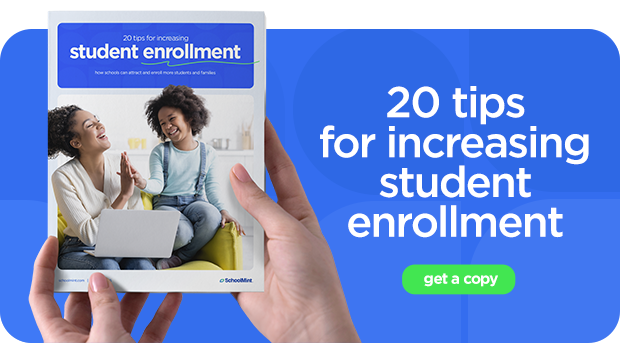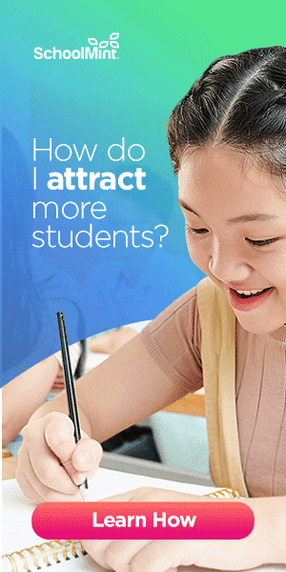Building Customer Personas for Your School
When you imagine the kind of family you want to enroll in your school, who do you see?
- What are they like?
- What do they want?
- And, most importantly, how can you give it to them?
This image in your head shouldn’t just be wishful thinking.
Instead, it should be the foundation for one of the most powerful marketing tools utilized by the biggest, most successful brands in the world: customer personas.
Creating customer personas for schools is a critical part of every school’s marketing plan. These personas don’t just help you visualize your current and target families but also, when done right, they’re essential tools to frame every decision you make about how to increase enrollment.
What a Customer Persona Is — and What It’s Not
A customer persona is essentially a fictional character you create to understand who your current and target families are.
You’ll eventually want to give this character a face and a name. But for now, ask yourself two basic questions:
- Who is this person?
- What do they want?
Often, people unfamiliar with using customer personas focus on raw demographic data — like the kind you can find on a driver’s license: Age, address, gender…
These are all valuable data points that can help you target your message.
For example, if your school’s target families speak Spanish at home, that will obviously influence how you communicate with them.
Also, families with lower income tend to connect to the internet on their phones instead of laptops or desktops. This means you need to ensure your website is mobile compatible (which you should be doing anyway).
However, sometimes these broad categories can be used as crutches.
The most useful information for your public school customer personas isn’t what these families look like. It’s understanding what they want:
- What does this family need?
- How can your school fill that need?
Building Public School Customer Personas: A Step-by-Step Guide
Your school likely contains a variety of families who bring different experiences to your campus and chose your school for different reasons.
The task of creating customer personas for schools is to look past all these peoples’ differences and think about what they have in common. Consider conducting a survey to get hard data about your school community.
While the process of creating personas is an art as much as a science, the better information you have going in about why families chose (or perhaps did not choose) your school is going to make your personas more powerful.
Here are some tips:
- Depending on your school, you might need more than one persona to capture the diversity of your student body.
- However, if you find yourself creating more than four or five personas, step back and consider if the differences between your personas are important (differences in wants and needs) or cosmetic (differences in raw demographic traits).
- Decide if you’re building a persona for the parents and guardians or the students. Family personas are most useful for K-8 schools; student personas are more applicable to high schools.
Interested in receiving more enrollment and school marketing insights like those in this article? Sign up for the SchoolMint Insider newsletter. Roughly every two weeks, we’ll deliver you school marketing, enrollment management, and recruitment advice!
The 7 Basic Elements of Customer Personas for Schools
Below are the seven basic questions you have to answer to create effective public school customer personas.
You want your answers to be as specific as possible, but don’t go on too long. An index card worth of information is plenty for each topic.
Question 1: What is This Person’s Name?
To make this persona feel real, you should give them a name to evokes an image of them in your head. Typically, this entails choosing a first name and pairing it with a one-word description of their primary trait.
For example, a school hoping to attract busy working parents might create a persona called “Busy Beth,” or a new charter school attempting to win over skeptical parents might create a persona called “Skeptical Sam.”
Question 2: How Would You Describe This Person?
In the description, dig a little deeper into your persona to visualize who this person is. Avoid demographic data (that’s coming next). Instead, think about this person’s needs and motivations when it comes to choosing a school.
For example:
- Busy Beth is highly motivated and successful but is tight on time. She wants a school that will put her child on a path to success, but she also needs a school that works with her schedule.
- Skeptical Sam attended traditional public schools his entire life and isn’t sure why he shouldn’t just send his child to his neighborhood public school down the street.
Question 3: What Are This Person’s Demographic Characteristics?
This is the raw data like age, income, race, etc. Again, this information is important, but often not as important as the rest of the persona.
In our examples, Busy Beth is an upper middle class married woman in her mid-40s, while Skeptical Sam is a working class man in his 30s.
Through SchoolMint Enrollment Academy, you can download a free parent persona template under the academy’s Marketing Resources section. This easy-to-fill-in Canva template provides an example persona as well as a blank copy so that you can create your own school personas.
Question 4: What Are This Person’s Goal and Needs?
Understanding your target’s goals and needs is the most critical part of creating a persona. Ask yourself, “What are the problems that this person has, and how can our school solve those problems?”
This can be a daunting task, but it’s the crux of the entire exercise.
To see how we can approach this question, let’s go back to Beth and Sam:
- Busy Beth wants to set up her child to be as successful as she is. She wants to give her child every advantage she can, although because of her work schedule, she isn’t able to spend as much time with her child as she would like.
- This might mean that Beth would be particularly excited to learn that your school offers enrichment classes like coding and robotics after school.
- Even if these classes are offered for a fee, Beth would gladly pay not only for the child care (which she has to pay for anyway) but also likes that they will give her child valuable exposure to STEM.
Skeptical Sam, on the other hand, might not know your public charter school exists. He might not even know what a charter school is! Sam wants to send his kids to the best school he can, but he doesn’t want to take risks with his children’s education.
Perhaps Sam would benefit from learning that the organization operating the new charter school has a proven track record elsewhere in the state.
Question 5: What Are the Barriers to This Person Enrolling in Your School?
What’s keeping your target families from choosing your school? And, more importantly, how can you overcome these barriers?
Beth is strapped for time. She’s committed to doing her research about all local schools, but she’s easily put off schools that make this research hard for her — whether through poorly designed websites, confusing communications, or lack of available tours.
For people like Beth, it is important to understand how your site looks through the eyes of a parent and guardian.
Sam’s district includes neighborhood public schools, magnet schools, and charter schools, each with its own admissions process.
Sam’s not clear on the distinctions between the schools, so unless he’s convinced otherwise, he’s not going to spend time trying to figure it out.
Question 6: How Can You Reach Them?
Of course, it won’t matter what you tell Beth and Sam about your school unless you have a good way of communicating with them.
- Since Beth is apt to do her own research, her first contact with your school will almost definitely be through your website.
- Sam, on the other hand, is unlikely to be looking for you. For Sam, you’ll likely have to find a way to contact him directly, perhaps through a trusted intermediary.
Which brings us to…
Question 7: What Influencers Can Help This Person Make Enrollment Decisions?
Who are Beth and Sam’s trusted sources for information?
- Since Beth is doing most of her own research, she might be influenced more by school rating websites.
- Sam is more likely to listen to other parents in his community.
Perhaps this means it’s worthwhile to have a current parent who lives near Sam to reach out to him personally, perhaps with a handwritten postcard.
Bringing it All Together and Defining Goals of Your Own
Now that you’ve answered the big questions, gather all the information together and post it on a board. Then find a photograph to go along with this persona, and put it on the wall in your office to make this person seem even more real.
Every time you face a decision that might affect enrollment, look at the personas you’ve created. Think to yourself, “How would Beth or Sam react?”
By molding your strategy around what you know about these personas, you’re going to greatly increase your chances of reaching the families just like them in your community.
However, you don’t have to wait for a decision to come across your desk to consider your personas. Be proactive and create some goals of your own for how you plan to reach these families.
Perhaps your goal with Beth is to wow her with your website, impress her with your after-school enrichment program, and get her to believe your public school will make her life easier while preparing her child for the real world.
With Sam, your first goal is probably to get him to know you exist so you can explain to him the advantages of your public school and get him to understand your school has a track record of providing an amazing education for free.
Keep the Process Going, Going, Going
Like many things in life, the process of creating public school customer personas is never done. As your school or community changes and you get more information about the families you serve, update your personas.
The more real you make them, the more useful they will be. And the easier it will be to turn the imaginary families in your head into enrolled students in your classrooms.
But creating parent personas is just the first step.
For 19 additional tips on increasing enrollment in your school and improving your school marketing efforts, check out our comprehensive guide, 20 Tips for Increasing Student Enrollment.
Share this
You May Also Like
These Related Stories

Using Customer Personas to Increase Enrollment

What is Your School’s Brand Personality? [QUIZ]





